
Enabling fast and accurate regulatory compliance for hours of service and commercial motor vehicle safety inspections in Ontario (CVOR) and Canada (NSC)
Create Account

ReadyChek's vehicle inspection reporting app is a fast and easy way to help drivers record paperless pre and post trip daily inspections and hours of service with Ontario's MTO vehicle schedules and Canada's NSC Standard 13.

Shows the app with all known data pre-filled to save driver time when performing the inspection.

Shows defects listed within the app to help driver select the appropriate defect for the problem.

Easy entry of daily duty status changes and operator has portal access to completed records
#readychekgo pretrip pre-trip inspection vehicle inspection circlecheck circle check facility audit MTO CVOR NSC paperless inspection
Inspections.

Drivers use the intuitive layout to fill in the results of their inspection using an Android phone/tablet or iPhone/iPad device.
Drivers don't have to look up or guess about the whether a certain defect puts their vehicle out of service, since the schedule parts and defect descriptions are provided with appropriate major and minor designations.
The results are saved to the device and also sent to the cloud for immediate viewing by the operator/safety manager in the ReadyChek web portal. A PDF can also be sent to a customized list of email recipients based on the results of the inspection.
Hours of Service

For this module, we are helping those operators that stay within the 160km radius. Even though there is an exemption from having ELDs, the operator is still required to maintain hours of service records for drivers in the case of a facility audit. Ontario is more strict than most provinces, but all must have documentation on the duty status hours and cycle.
For Ontario, see HTA Regulation 255/06 Section 23, subsection 3 that outlines what information operators must maintain for drivers.
ReadyChek provides a simple to use tool for drivers to record their start/end locations, duty status changes and daily totals, so their operators can refer to this information during a facility audit.
Keeping drivers and other road users safe is our primary goal at ReadyChek, Inc. As a leading-edge provider of mobile technology aimed at short haul commercial motor vehicle drivers, we improve safety checks by increasing their accuracy for commercial vehicles and help companies meet compliance regulations with an easy-to-use mobile app and admin web portal.
Our founders had a shared vision to help drivers and their operators spend more time taking care of business in the field and office, and less time completing and filing paperwork. With over 30 years in the design and development of reliable, user-friendly software solutions, ReadyChek strives to make recording inspections a simple and pain-free experience.
Contact us today to learn more about the ReadyChek story, and join our growing list of satisfied customers.
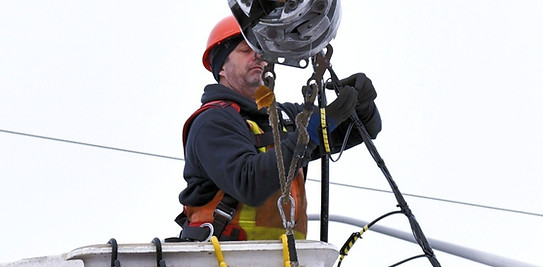
ReadyChek has partnered with
Tri-Shield Consulting
Retired Police Commercial Vehicle Inspectors
CVSA Associated Membership
94 years of Front Line Patrol and Traffic and Marine Services
33 years of Commercial Motor Vehicle Enforcement and CVSA Inspections
Pre-trip/Roadside Inspection training courses available
WHY USE READYCHEK?
ReadyChek is a revolution in vehicle inspection reporting, with an easy to use layout that will have you on the road quickly and not sitting in the yard filling out paperwork. Let ReadyChek manage all of your vehicle inspection records for every vehicle in your fleet. No more filing cabinets or boxes full of vehicle inspection reports, and no more lost papers or inspection books. This will save your organization time, office/storage space and money.
As a Canadian company, based in Waterloo, Ontario, we adhere to the federal regulations regarding data privacy as described in the Personal Information Protection and Electronic Documents Act (PIPEDA). All customer data is kept in Toronto, Canada.
ReadyChek is MTO compliant with the Highway Traffic Act, R.S.O. 1990, c. H.8, Regulation 199/07 and is compliant nationally with National Safety Code Standard 13.
ReadyChek currently supports Schedules 1, 2 and 5 for trucks, buses and school buses, but expects to add additional schedules based on customer demand.

Billed Monthly Based on Usage
New Inspection registrations will have a time-limited trial with multiple users/vehicles/trailers before having to commit to any payments
------------
New Hours of Service registrations will have a time-limited trial with multiple users before having to commit to any payments
Unlimited Vehicle Inspection Reports
Unlimited Users/Duty Status reports
Phone/Email Support
Free ReadyChek App downloads
Minimum 30 day trial with no limits
on vehicles, trailers, users, inspections or duty status records
Inspection Module
Maint fee + Usage Costs per month
$1/(Vehicle/Trailer) + $0.50/Inspection report
Unlimited Vehicles/Trailers/Users
Hours of Service Module
$0.35/Daily Duty status record
when "On Duty" status is recorded
No Charge for "Off Duty" days
(if not bundled with Inspections, cost is .50/On Duty day)
Unlimited Users
Contact Us for Details!
Testimonials
In the last week of July, we had our annual inspection by the MTO.
I would like to report that the officer was quite happy with the performance of the ReadyChek app. The officer reported that everything needed for a pre-trip was covered in the app and that the app was in full compliance."
- Lawrence Lambkin, Kiwanis Transit
ReadyChek has simplified the daily inspection routine and removed the possibility of errors in the paperwork. The app is well thought out and easy to navigate. Click on the picture of the unit being inspected and the information is populated in the report. No chance for errors. In the case of roadside inspection or audit, the report is easy to produce.
- Shadow Enterprises LTD
Get ReadyChek now
If you are interested in registering your company with ReadyChek, please fill out our registration form and we can arrange a consultation.
Available on Android and iPhone

Software as a Service Agreement

Be Part of the Ultimate Safety & Compliance Community
Trending news, knowledge-building content, and more – all personalized to you!

Pre-trip inspections - Ontario
Application.
Ontario’s pre-trip inspection regulations apply to all commercial motor vehicles with a gross weight or registered gross weight of more than 4,500 kilograms.
The regulations do not apply to commercial motor vehicles with a gross weight or registered gross weight of 4,500 kilograms or less, and vehicles such as, but not limited to, ambulances, motor homes, commercial motor vehicle leased for 30 days or less by an individual for personal use, historic vehicles, pick-up trucks being used for personal purposes, or buses used for personal purposes without compensation. Also exempt from the requirements are vehicles such as emergency vehicles, vehicles providing relief in a flood, drought, etc., two- or three-axle vehicles used to transport farm products, or commercial motor vehicles being road-tested for the purposes of repairs within 30 kilometres of the repair facility (where the vehicle is being repaired by the holder of a qualification certificate that is not suspended in the trade of automotive service technician or truck and coach technician licensed under the Ontario College of Trades and Apprenticeship Act, 2009 , or an apprentice under that Act).
Requirements
Drivers (or in some cases designated inspectors) are required to inspect vehicles prior to operating the vehicles. Pre-trip inspections are valid for 24 hours.
Ontario regulations contain inspection “schedules” that drivers must use when inspecting the vehicles. The inspection schedules list vehicle parts and what defects would be considered minor defects or major defects of those vehicle parts. A carrier is free to add items or remove items from the schedules to make the inspection list more applicable to the carrier’s operations and to assist in vehicle inspections. Drivers must carry the applicable schedule in the vehicle during operation.
The following inspection schedules are available in Ontario Regulation 199/07, Commercial Motor Vehicle Inspections :
- Schedule 1, Daily Inspection of Trucks, Tractors and Trailers
- Schedule 2, Daily Inspection of Buses and of Trailers Drawn by Buses
- Schedule 3, Daily Inspection of Motor Coaches
- Schedule 5, Daily Inspection of School Purposes Buses
- Schedule 6, Daily Inspection of School Purposes Vehicles
Schedule 4, Under-Vehicle Inspection of Motor Coaches, applies to the motor coach under-vehicle inspection required. An under-vehicle inspection is valid until the 31st day after it is conducted or until the motor coach has been driven 12,000 kilometres, whichever occurs last (this inspection is only valid in Ontario if it is performed by a truck and coach technician holding a valid certificate of qualification, that is not suspended, issued under the Ontario College of Trades and Apprenticeship Act, 2009) .
If a motor coach is inspected according to Schedule 3 above, then the driver must also be in possession of a valid inspection report, documenting an inspection performed in accordance with Schedule 4.
Ontario accepts either the inspection schedules from Ontario Regulation 199/07 or the schedules consistent with National Safety Code, Standard 13, Trip Inspections.
Inspection reports
Carriers are required to provide inspection forms and the applicable inspection schedules to drivers (or designated inspectors).
Upon completing the inspection, the driver must document the inspection on the pre-trip inspection report. An inspection report must contain the following items:
- Vehicle’s licence plate number and plate jurisdiction;
- Operator’s name;
- Inspection date and time;
- City, town, village, or highway location where the inspection was conducted;
- Printed name of the person who conducted the inspection;
- Odometer reading;
- Any major and minor defects found during the inspection or, if none were found, a statement that no major or minor defects were found (a “no defects found” check box will suffice);
- A statement, signed by the person who conducted the inspection, that the vehicle was inspected according to Ontario Regulation 199/07, Commercial Motor Vehicle Inspections ; and
- The driver’s signature, if the driver is not the person who conducted the daily inspection of the commercial motor vehicle.
Reporting defects to the carrier
If any defects are found during the pre-trip inspection, a driver must immediately report them to the carrier. Defects must be repaired before a driver can operate the vehicle.
A driver is required to monitor the condition of the vehicle while in operation. If any defects are found during operation of the vehicle, the driver must update the inspection report and notify the carrier of the defects. If major defects are found during operation, the driver must cease operation of the vehicle and report the defects to the carrier immediately.
Recordkeeping
Drivers must submit the completed daily inspection reports to the carrier as soon as possible after the inspection is no longer valid, no later than 20 days after the inspection is no longer valid. Carriers are required to keep the inspection reports for at least six months from the date of the inspection. If the inspection report contains information on vehicle repairs, then the inspection report becomes a maintenance record and must be kept for at least two years. Even if the inspection report contains defects that were later determined to not actually be defects, the report still becomes a maintenance record and must be kept for at least two years.
Any required maintenance record or document may be made, kept, or surrendered in electronic format if it meets the requirements. An electronic record or document must meet every requirement of the trip inspection regulations, except that it is not required to have a signature.
Upon demand of a police officer or officer, a driver who carries a daily inspection report, under-vehicle inspection report, or inspection schedule in electronic format must produce either:
- An electronic display of the report or schedule, that is readable from outside the vehicle;
- A printed copy of the report or schedule, signed by the driver; or
- A handwritten copy of the report or schedule, signed by the driver.
Despite the fact that operators are required to keep records at the operator’s principal place of business (or other terminal or business address), operators may keep a record or document that is in electronic format at any place if it can be readily accessed by the operator from the operator’s principal place of business in a format that would allow a printed copy of the record or document to be generated as required.
Upon demand of a police officer, an operator who has in their possession a record or document in electronic format shall generate a printed copy of the record or document, signed by the person who makes the copy.
Enforcement
Ontario has issued an enforcement policy on its pre-trip inspection requirements:
- Carriers based outside of Ontario in other Canadian jurisdictions must have an inspection report in compliance with the regulations in the carrier’s base province (based on National Safety Code Standard 13) or can comply with Ontario’s pre-trip inspection regulations; and
- U.S.-based carriers must be prepared to show the previous days’ written post-trip inspection report (defects or no defects, a written report is required).
In all cases, Ministry of Transportation-Ontario reserves the right to issue a citation to any driver that fails to produce proof that an inspection was performed or who is driving with a major defect.
Highway Traffic Act
Ontario Regulation 199/07, Commercial Motor Vehicle Inspections
261 Seneca Road, Sherwood Park, AB, T8A 4G6
Daily Pre-Trip Inspection
Daily Pre-Trip Inspection Buy Now | $89.95
This online course provides drivers with an understanding of how to properly perform their required inspections, as per National Safety Code compliance, and explains how to address any defects that may be found.
Course Overview
This online driver training course provides instruction on how to perform vehicle inspections that comply with the National Safety Code. While most vehicle inspection courses only list the items that need to be inspected, this course goes further by using professional videos to show truck drivers how to perform required truck inspections. Additionally, this course explains how to react to potential vehicle defects that are found during a vehicle inspection.
Understanding and effectively applying the vehicle inspection concepts explained in this online course will help truck drivers keep their vehicle road safe.
Course Topics
In this online Pre-Trip Inspection course, the following topics are covered:
Module 1: Preparing for the Pre Trip Inspection
This module covers how a truck driver should perform a pre trip inspection and includes the necessary safety precautions that should be taken while all vehicle inspections are performed. This module also discusses the National Safety Code (Standard 13) and how it relates to the C.V.S.A. inspection that an enforcement agency may perform.
Module 2: Inspecting the Air Brake System
The focus of this module is how air brakes work and how to properly perform an air brake test. Examples of possible air brake defects, as well as steps to take when a brake problem is identified are also covered.
Module 3: Defects and Major Defects
This module thoroughly covers the inspection items listed on a vehicle inspection form and includes information on potential vehicle defects as well as solutions if those defects are discovered.
Module 4: Performing the Inspection
Building on the concepts learned in the first three modules, the steps for performing a complete vehicle inspection are demonstrated.
Course Duration
This course takes approximately 60 minutes to complete
Course Pass Mark
A passing grade of 80% or higher required. Up to 3 attempts are provided.
Course Certificate
A certificate will be provided upon the successful completion of this course.
Buy Now | $89.95

Making sure drivers and roadways are safe is a major concern for commercial truck drivers and operators. Daily pre-trip vehicle inspections are designed with these safety concerns in mind – to protect drivers, alert carriers to mechanical problems, and achieve a higher level of safety and compliance in commercial vehicles operating on the highway or in the city.
It is important to understand how to perform a proper pre-trip inspection to ensure your vehicle is able to make the trip to its destination safely.
Read on to learn more about the basics of pre-trip inspections of tractor trailers, and how to perform a proper inspection.
What Is Pre-Trip Inspection?
A pre-trip inspection involves the driver performing a thorough check of his or her vehicle, making sure each part is working as required. The purpose of these daily vehicle inspections is to identify and report any defects on your commercial vehicle, and to help take vehicles with safety concerns that are likely to lead to a collision or vehicle breakdown off the roads until proper repairs are made.
Finding and addressing problems with proper pre-trip inspections can help drivers avoid costly HTA violations that can lead to high fines. Catching potential safety issues early can also help reduce the length and frequency your vehicle is out of service for repairs.
When Is A Pre-Trip Inspection Required?
Drivers of a commercial truck or tractor trailer with a gross weight exceeding 4,500 kg are responsible for completing a schedule 1 pre-trip inspection on their vehicle.
A pre-trip inspection is required before the start of each driving shift and once over the course of every 24 hours while on the road. Before heading out on the road, drivers are required by law to inspect their truck and trailer for possible mechanical issues and safety concerns.
How Long Should A Pre-Trip Inspection Take?
There is no regulated time requirement for pre-trip inspections. However, a complete pre-trip inspection can generally take drivers anywhere from 20 to 50 minutes .
How To Do A Proper Pre-Trip Inspection
Follow these inspection points when completing a pre-trip inspection on your tractor trailer, noting any defects you find.
Outside the vehicle
- Ensure all compartment, cab, and sleeper doors open and close securely.
- Check all cargo is properly secured with undamaged, unworn load covering and securement devices.
- Inspect coupling devices for loose or missing fasteners.
- Inspect exhaust system for leaks, including within the driver cab area.
- Ensure the fuel tank and fuel are secure and free of leaks.
- Identify any general vehicle damage or deterioration.
- Check mirrors and windows are free of cracks or damage and are properly secured.
- Ensure lamps and reflectors are undamaged and functioning properly.
- Inspect suspension system for air leaks, missing or broken fasteners or spring leaf.
- Check the tread and sidewall of tires for damage or wear. Ensure there are no flat tires or air leaks, no contact between tires and other vehicle components, and there are no exposed cords.
- Ensure wheel hubs and fasteners are secure, undamaged, and not leaking. Hub oil should be above the minimum level.
Inside the vehicle
- Inspect driver seat for damage, ensuring seat can be set and remain in proper position.
- Check that seat belt is secure and can be properly fastened.
- Ensure emergency equipment and safety devices are accessible and undamaged.
- Inspect the frame and cargo body for shifting, sagging, or other damage.
- Ensure heater/defroster is operating correctly.
- Check the vehicle’s horn is operating correctly.
Vehicle controls
- Check the air brake system, noting any air leaks, air pressure loss, or inoperational service, parking, or emergency brake.
- Ensure the parking brake is operative.
- Ensure driver controls including the accelerator, clutch, gauges, and indicators are functioning properly.
- Check headlights are operating, including: low beams, tail lamps, turn signals, and brake lamps.
- Inspect steering wheel, ensuring it is secure, functioning properly, and wheel lash is within normal range.
- Ensure windshield wipers are functioning, and blades are not missing or damaged. Wipers should adequately clear driver’s field of vision.
For more information on pre-trip inspection requirements, download the full CDL Pre Trip Inspection Checklist here.

Creating Truck Pre Trip Inspection Forms for Canada-wide Compliance

A pre-trip inspection is a crucial step in ensuring the safety of drivers and others on the road. It involves checking various components of a truck to make sure it is in good working condition and free from defects that may cause accidents. In this blog post, we will provide tips for creating pre-trip inspection forms that comply with CCOHS, NSC, and CCOHS guidelines.
We also cover modern tips for making forms easier and the consequences of not filling out pre trip inspection forms in Canada.
Tip 1: Follow CCMTA, NSC, and CCOHS Guidelines
To stay Canada-wide compliant it’s best to include guidelines from CCMTA, NSC, and even the CCOHS. This requires reviewing the following:
- Engine Compartment: This section should include items such as checking oil levels, checking hoses and belts, inspecting the air filter, and checking for any leaks.
- Cab Inspection: This section should include checking for any damage to the windshield, mirrors, lights, and windshield wipers. It should also include checking the horn, emergency brakes, and seat belts.
- Front End: This section should include checking the steering system, brakes, tires, and wheels.
- Trailer Inspection: This section should include checking the trailer’s brakes, tires, wheels, and lighting system.
- Rear End: This section should include checking the rear lights, brakes, tires, and wheels.
- Specialized Equipment: If the truck has any specialized equipment, such as a liftgate or refrigeration unit, it should be included in the inspection form.
- Documentation: The inspection form should also include a section for documenting any defects found during the inspection and the actions taken to address them.
It’s important to note that the specific details and items on the pre-trip inspection form may vary depending on the type of truck and the industry in which it operates. However, the items listed above are generally included in most pre-trip inspection forms for trucks in Canada.
For more info on a Canada-wide compliant truck pre-trip inspection form, see the National Safety Code (NSC) Standard 13 pre-trip inspection form . This form is designed to meet the requirements of the Canadian Council of Motor Transport Administrators (CCMTA) and the National Safety Code (NSC) Standard 13 for pre-trip inspections.
The NSC Standard 13 pre-trip inspection form includes sections for both the driver and the vehicle. The driver section includes a checklist of items that the driver needs to inspect, such as the seat belts, mirrors, and brakes. The vehicle section includes a checklist of items that the driver needs to check on the truck, such as the tires, lights, and engine.
The NSC Standard 13 pre-trip inspection form is designed to be easy to use and understand, with clear instructions and visual aids to help drivers conduct a thorough inspection. The form also includes spaces for drivers to document any defects or issues they find during the inspection, along with instructions for reporting these issues to their fleet managers.
Overall, the NSC Standard 13 pre-trip inspection form is an example of a Canada-wide compliant truck pre-trip inspection form that meets the guidelines and requirements set out by the CCMTA and the NSC. Using a compliant pre-trip inspection form like this can help to ensure the safety of drivers and others on the road by identifying and addressing any issues with the truck before it is driven.

Tip 2: Make Your Truck Pre trip Inspection Form Easy to Complete
Truck pre-trip inspections are an essential part of ensuring the safety of drivers and others on the road. However, they can be time-consuming and often require a significant amount of effort from drivers. Here are some tips for making pre-trip inspections easier for truck drivers:
- Provide clear and concise instructions: Drivers need clear instructions on how to conduct pre-trip inspections. The instructions should be easy to understand and concise, providing drivers with a step-by-step guide on what to check and how to document any issues they find.
- Offer training and support: Some drivers may be new to the pre-trip inspection process or may not be familiar with the specific components of their truck. Offering training and support can help to ensure that drivers are confident and knowledgeable about conducting pre-trip inspections. This can also help to reduce errors and improve the accuracy of the inspection process.
- Make the inspection checklist visible: Drivers should have easy access to the pre-trip inspection checklist. Making the checklist visible in the cab of the truck can help to remind drivers of what they need to check and ensure that they do not miss anything.
- Encourage communication: Drivers should feel comfortable communicating any issues they find during the pre-trip inspection process. Fleet managers should encourage open communication and make it easy for drivers to report any issues or concerns they have. This can help to address issues quickly and prevent them from becoming significant problems.
Tip 3: Use Software to Organize all your Pre Trip Inspection Forms
Digital forms are the most common piece of software used to simplify pre trip inspection forms. These digital pre trip inspection forms are easy to use and allow for data collection and analysis. With digital forms, the information collected can be stored and analyzed to identify trends and potential issues. This information can then be used to make improvements to the pre-trip inspection process and the overall safety of the fleet.
There are several software solutions available that can help with the data collection and analysis of pre-trip inspection forms. Some popular solutions include Fleetio, Whip Around, and KeepTruckin. These solutions allow for digital data collection, analysis, and reporting, making it easier for fleet managers to identify issues and make improvements.
Furthermore, digital forms can also provide real-time feedback to drivers, allowing them to address any issues before they become significant problems. With digital forms, drivers can easily document any issues they find during the inspection, and fleet managers can receive alerts and notifications about these issues. This allows for prompt action to be taken, reducing the risk of accidents and increasing the overall safety of the fleet.
In addition, using digital forms can also reduce paperwork and administrative tasks. Traditional paper forms require significant time and effort to create, distribute, and process. Digital forms, on the other hand, can be created quickly and easily, and the information collected can be automatically processed and analyzed. This saves time and resources, allowing fleet managers to focus on other critical tasks.
Another advantage of using software solutions for pre-trip inspections is that they can be customized to meet the specific needs of each fleet. Fleet managers can modify the inspection form to include additional items that are relevant to their fleet, such as specialized equipment or safety features. This flexibility allows for a more comprehensive inspection, ensuring that all critical components of the truck are checked before each trip.
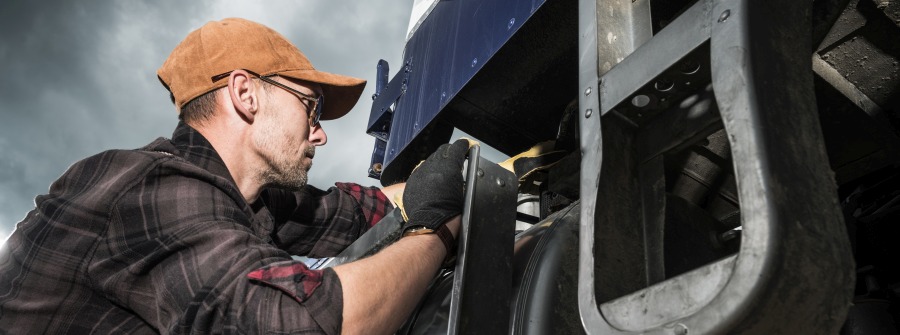
Consequences for not Performing Pre Trip Inspection Forms
In Canada, the fines that truckers can receive for not performing pre-trip inspections can vary depending on the province or territory. However, generally, the fines can range from $250 to $1,000 for a first offense, and can increase for subsequent offenses.
For example, in Ontario, under the Highway Traffic Act, a commercial vehicle driver can be fined $250 for failing to perform a pre-trip inspection or failing to carry out a required safety inspection. The fine increases to $500 for a second offense within a year and $1,000 for a third or subsequent offense within a year.
It’s important to note that pre-trip inspections are not only required by law but also crucial for ensuring the safety of the driver, the vehicle, and other road users. Therefore, it’s essential for truckers to perform pre-trip inspections thoroughly and regularly to avoid fines and ensure safety on the roads.
Related Posts

Simplifying Employee Tax Forms with Software

Could Your HR and Safety Onboarding be More Efficient?

Digital Forms Are Reshaping Job Sites

Safety Tips for Shipping Dangerous Goods

10 Vital Benefits of Training and Tracking Compliance Software

Go Paperless or Pay for Tradition

Albertan e-learning providers donate $300,000 in courses to rural youth education

Tips to Improve Worksite Safety
- Previous Post
Download the Course Development Feature Sheet

Please fill in your name and email below
Download the safetapp feature sheet.

Download the 2023 Product Roadmap
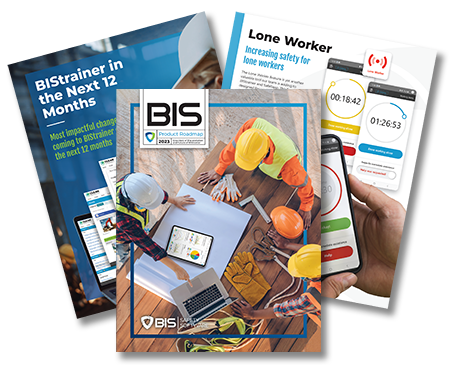
Please fill in your name and email below to download the Referral Program PDF
Download the online onboarding guide.

Download the Online Orientation Feature Sheet
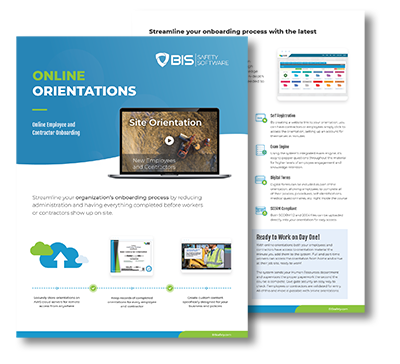
Download the Toolbox Talk Feature Sheet
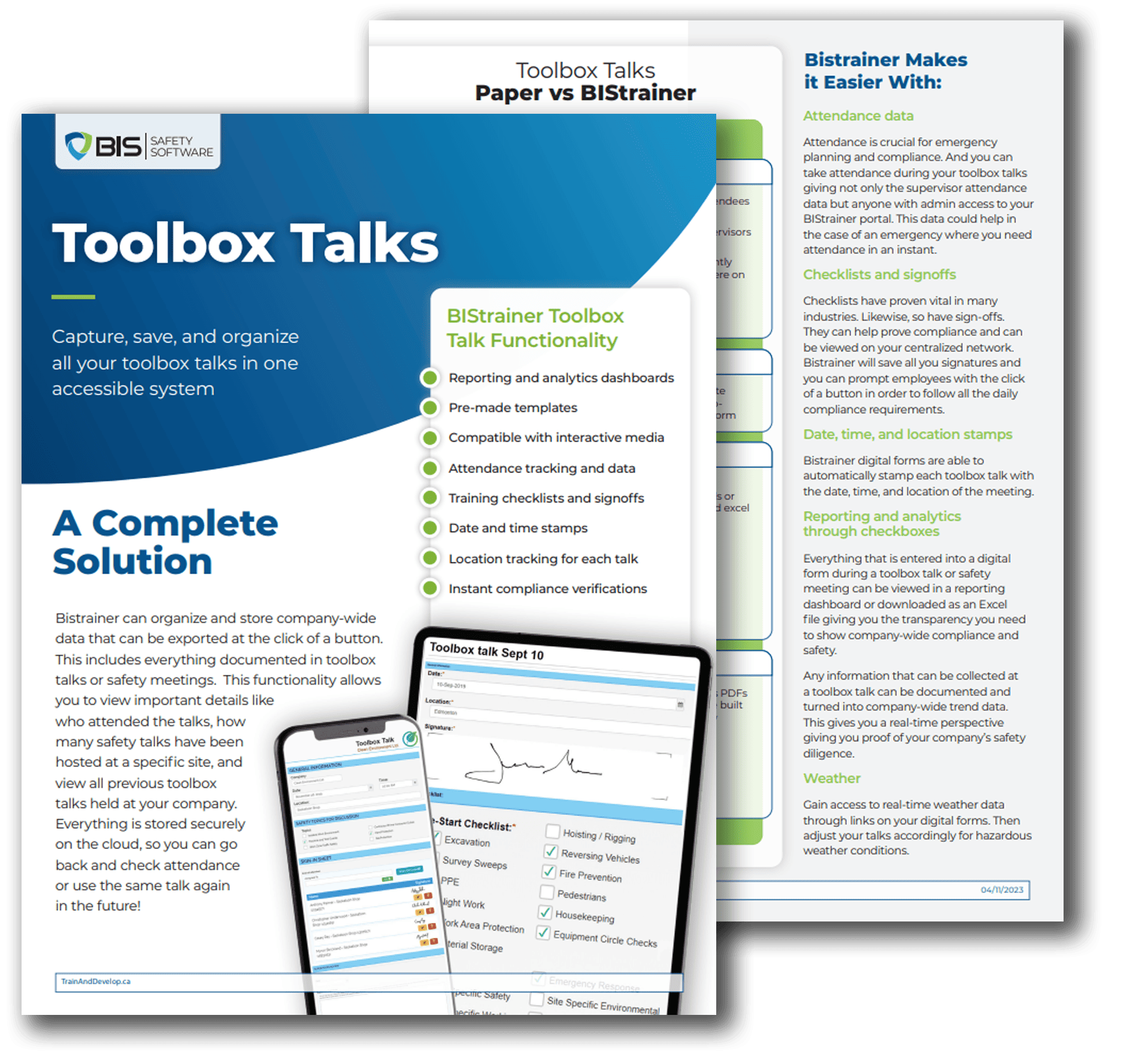
Complaint and Investigation Form
Your name (optional)
Your email (optional)
Your phone number (optional)
Please describe your concern (required)*
Upload a file - max 15MB (optional)
BIS will investigate your concern. If you provide your contact information, we may contact you for more information.

Sign Up Today!
Get notified when tickets become available, download the course owner feature sheet.

Contact Our Privacy Team
Download the incident management feature sheet.
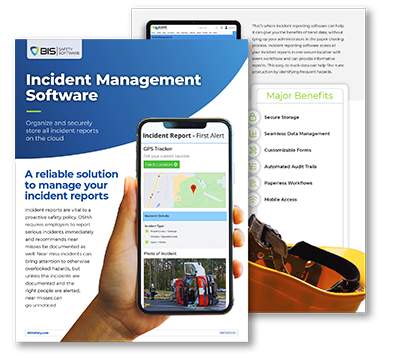
Download the Driver Management Feature Sheet

Download the Digital Folder Storage Feature Sheet

Download the LMS Feature Sheet
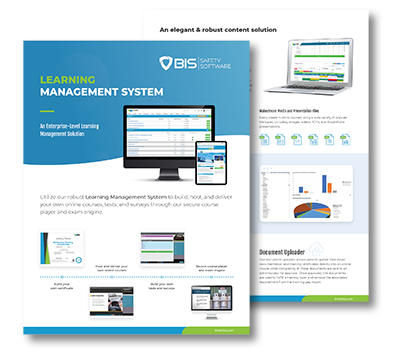
Download the Training Record Management Feature Sheet

Download the Calendar Feature Sheet

Download the Reseller/Network Partner Feature Sheet
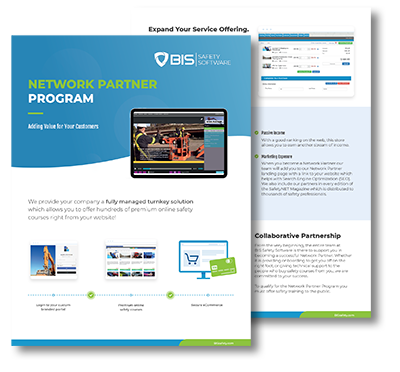
Download the Course Library Feature Sheet
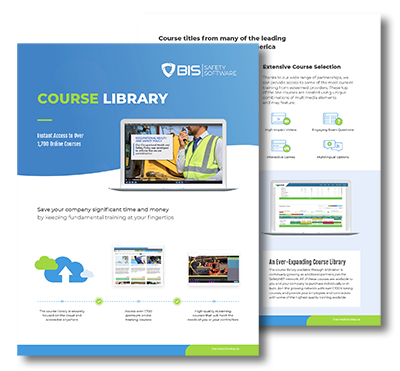
Download the Training Matrix Feature Sheet

Download the EHS Software Brochure

Download the LMS Buyer’s Guide

Request a Demo
Download the digital forms feature sheet.

Download the Reporting Feature Sheet
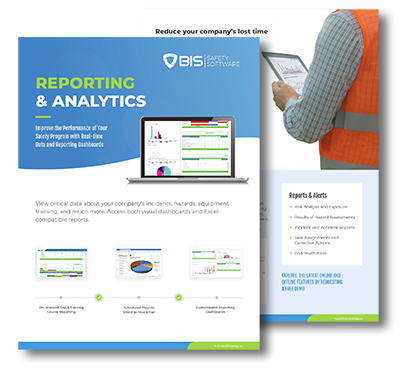
Download the Corporate Client Feature Sheet
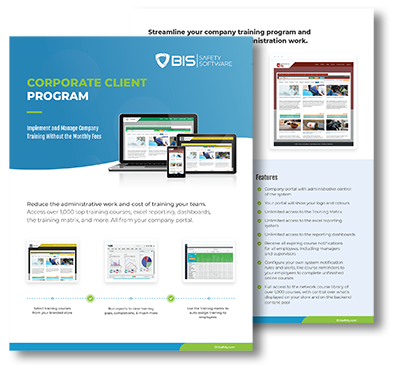
Download the Linked Assets Feature Sheet
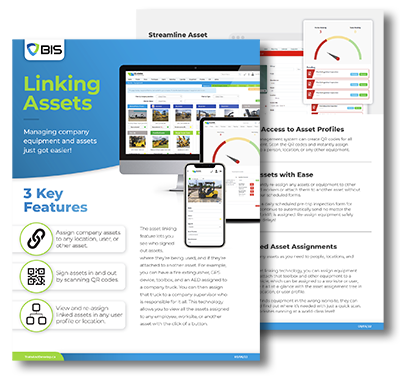
To Download the Combatting Complacency Guide

Download the TRMS Buyer’s Guide

Download the Training Record Management System Comparison Chart
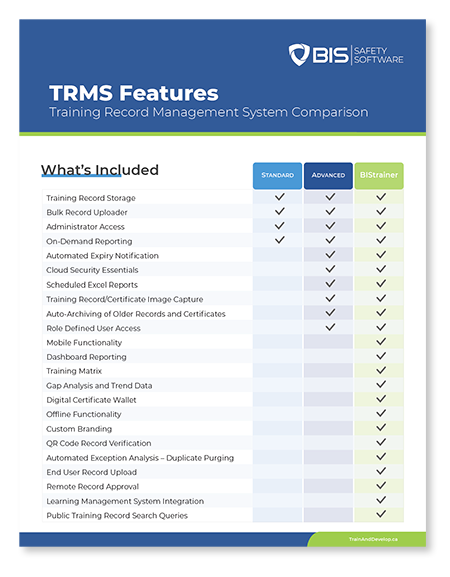
Download the Learning Management System Comparison Chart
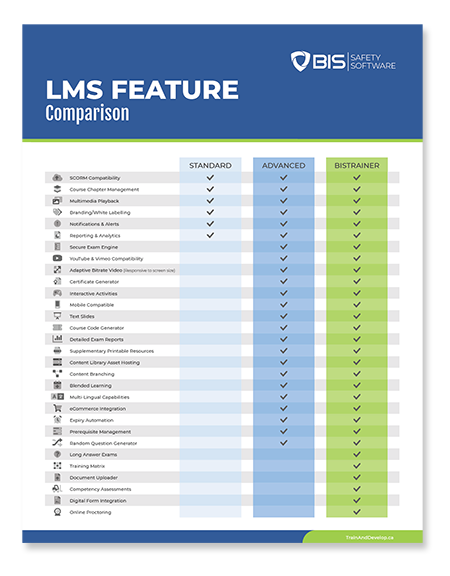
Download the Field Level Hazard Assessment Feature Sheet

Download the Equipment Management Feature Sheet
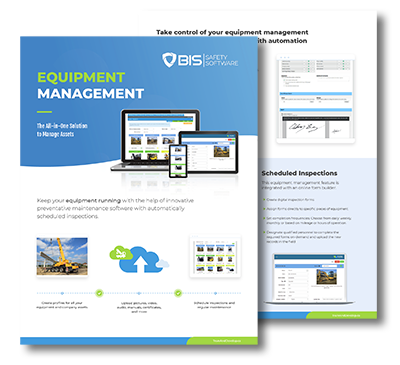
- Business Tips
- Digital Archive
- Test Drives
- Sustainability
OTDC: How to do a perfect pre-trip
by James Menzies with videographer Austin Hitchcock
LONDON, Ont. — One of the most daunting elements of the Provincial Truck Driving Championships is the pre-trip inspection, which must be completed in less than eight minutes under the supervision of a uniformed transport enforcement officer.
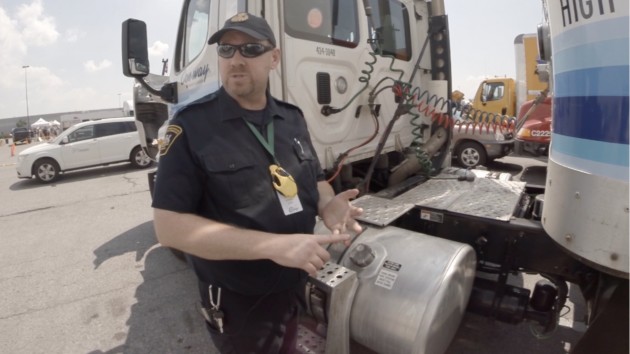
Defects have been planted on the vehicle, which the competitor must identify. This year in the Ontario Truck Driving Championships, for the first time ever, three drivers aced the pre-trip with perfect scores. They were: Mike Hamilton, City of Brampton; Wayne Burnett, Home Hardware; and Rob Hunter, Waste Management.
We asked transport enforcement officer and judge Chad King from the MTO’s Vineland station to walk us through the pre-trip inspection component of the competition and to offer some tips on how to complete a perfect pre-trip. King explains that the level of competition has increased over the years, making it more difficult to plant defects that go unnoticed.
While all drivers have their own processes and can begin the inspection wherever on the vehicle they choose, King starts at the front of the truck and works his way back. When checking the wheel fasteners, also be sure to check the washers to ensure they’re secure, King advises. He also reveals the first of five planted defects.
King gives an overview of the brake system components and fluids that should be checked at the front of the vehicle, before working his way down alongside the frame rails. He inspects the fuel tank to ensure it’s secure as well as the air lines and along the way, he uncovers the second planted defect.
As he works his way along the vehicle, King checks the trailer air tanks to ensure they’re well connected. He inspects the frame rail for cracks and looks for bulging along the side of the trailer that would indicate an insecure or overwidth load. He also examines the landing gear and ensures mudflaps are in place.
King moves to the back of the trailer and inspects the door as well as the marker lights. He ensures the conspicuity markings are visible and examines the trailer wheels and brake systems. He also inspects the suspension system.
On the passenger side of the truck, King inspects the landing gear and underhood components. Along the way, his inspection reveals two more planted defects. He also touches on what drivers should be looking for inside the cab.
Having given us an overview of the pre-trip inspection, King had nothing but praise for the drivers who took part.
“We had some drivers who did really well this year,” he said. “These guys are getting better and better each year, which is good. It means the safety programs at their companies are working and companies are taking due diligence to ensure their drivers are operating safely on the road. We like to see that.”
And on a personal note, King, who’s participating as a judge for his third year, said it’s a nice opportunity to get to know the professional drivers in a more relaxed setting than what may exist at a roadside inspection station.
“Coming to an event like this, it’s a lot more laid back,” he said. “So we can have a little bit more camaraderie with the drivers, talk to them about different things and get to know them on a different level and they can do the same with us. It’s a great environment for us to work cooperatively together.”
The five planted defects:
- Loose pitman arm
- Loose electrical line connection
- Leaking wheel hub
- Missing placards
- Missing mudflap on the trailer
Have your say
This is a moderated forum. Comments will no longer be published unless they are accompanied by a first and last name and a verifiable email address. (Today's Trucking will not publish or share the email address.) Profane language and content deemed to be libelous, racist, or threatening in nature will not be published under any circumstances.
Your Name *
Your Email *
Save my information for next time
The one day that I dread is when I am to be convinced there is no room for improvement. Don’t just Drive safe.
Thank you for visiting truckandtrailer.ca!
We have changed the way we showcase trucks and trailers available for sale – and now send the details right to your email inbox.
Simply click here to subscribe to our bi-weekly HD Hotlist for the listings.
We use cookies to make your website experience better. By accepting this notice and continuing to browse our website you confirm you accept our Terms of Use & Privacy Policy .
read more >>
(866) 756-5552 Resources | Locations
- TDG by Ground
- Fall Protection
- Aerial Work Platforms
- Confined Space
- Workplace Hazards
- Environmental Hazards
- Equipment Safety
- Dangerous Goods
- Driver Safety
- HR & Basics
- WHMIS Train the Trainer – Online
- TDG Train the Trainer – Online
- Ground Disturbance for Supervisors Train the Trainer – Online
- Agriculture & Forestry
- Construction
- Health Care
- Manufacturing
- Mining, Oil & Gas
- Office & Administration
- Transportation & Warehousing
- JHSC Part 1 – Ontario
- JHSC Part 2 – Ontario
- JHSC Refresher – Ontario
- Workplace Violence & Harassment for Workers
- Health and Safety Awareness for Supervisors
- Health and Safety Awareness for Workers
- Ground Disturbance for Supervisors
- Calgary Calendar
- Edmonton Calendar
- Blended Fall Protection – Calgary
- Blended Fall Protection – Edmonton
- ESC Fall Protection – Calgary
- ESC Fall Protection – Edmonton
- Blended Confined Space – Calgary
- Blended Confined Space – Edmonton
- ESC Confined Space Entry and Monitor – Edmonton
- New Operators – Calgary
- Experienced Operators – Calgary
- Experienced Operators (Blended) – Calgary
- Emergency First Aid
- Forklift Training (Calgary Area)
- Mask Fit Testing
- Mobile Elevating Work Platforms (Calgary Area)
- Standard First Aid
- Blended Fall Protection – Langley
- Blended Fall Protection – Richmond
- Fall Protection – On Site
- Mississauga
- Toronto (East)
- Toronto (North York)
- Online – Instructor Led
- Mask Fit Testing – On Site
- Standard First Aid – On Site
- Emergency First Aid – On Site
- Blended Confined Space – Barrie
- Blended Confined Space – Mississauga
- Blended Confined Space – Toronto (East)
- Blended Confined Space – Vaughan
- Blended Training – Waterloo
- Working at Heights
- Working at Heights – Refresher
- Confined Space Entry
- Confined Space Rescue
- Forklift Training
- Mobile Elevating Work Platforms
- Self Study Books
- Reference & Handbooks
- Instructor Materials
- Foot Protection
- Hand Protection
- Eye and Face Protection
- Hearing Protection
- Head Protection
- Respiratory Protection
- Corporate Accounts
- Our Services
- Managed Health & Safety Subscription
- Online Training Subscription
- ISNetworld Compliance
- On Site Safety Management
- Training Development
- Training & Tracking Platform
- Call (866) 756-5552
PRE-TRIP INSPECTIONS CERTIFICATION
$ 49.95
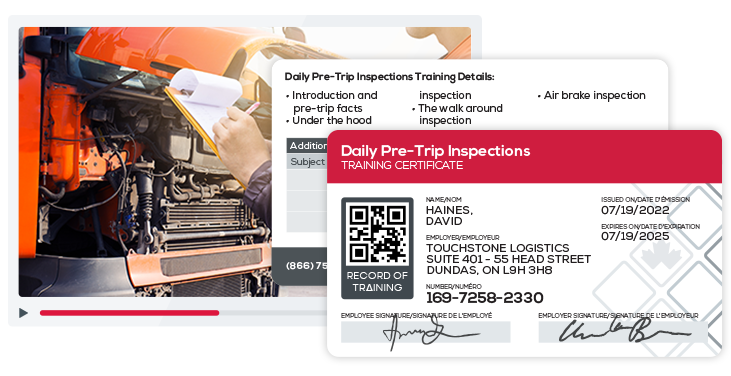
Quantity Discounts
Home > Products > Training > Online Certifications > Daily Pre-Trip Inspections
Trusted By Thousands of Organizations


DAILY PRE-TRIP INSPECTIONS
Pre-trip inspections are an integral part of every road trip for a trucker.
Proper pre-trip inspections are important for proper fleet maintenance and they are required by law.
Finding problems at the yard before you leave on a run will save a problem down the road, and more specifically a costly repair on the side of the road.
Pre-trips are mandatory under current regulations and drivers are accountable and responsible for defects found on their units.
Understanding and effectively applying the vehicle inspection concepts explained in this online course will help truck drivers and their fellow drivers around them road safe.
COURSE OUTLINE:
- Introduction and Pre-Trip Facts.
- Under the Hood Inspection.
- The Walk Around Inspection.
- Air Brake Pre-Trip Inspection.
- Post Trip Inspection.
PRE-TRIP INSPECTIONS COURSE ASSESSMENT:
Testing conducted throughout this online course is designed to reinforce the information presented. Participants are able to repeat the course as many times as is needed if the pass mark is not achieved on the first attempt.
Satisfaction Rating
4.66 Average 10157 Reviews
Course Outline
1. under the hood.
Start your trip by opening the hood and checking the four main parts of your engine that need to be regularly monitored, the fluid levels, belt wear and tear, wire connections, and if the hoses are secured.
2. The Walk Around
The walk-around inspection of your truck is a necessity each day to ensure there have been no changes from the last trip. Taking the time to do a full 360* view of the truck is imperative to prevent unnecessary risks.
3. Air Breaks
It is ultimately the driver who must ensure the brake systems are working properly in their truck. Understanding how the system works, testing the system, and knowing how to react in an emergency is a top priority for every driver.
4. Post Trip Inspection
The National Safety Code provides a list of items and requirements for post-trip inspections and routine maintenance. This inspection is to report any changes to the truck, schedule maintenance, deal with hazards, and report any findings.
Bulk Discounts. Free Tools.
Depending on how many training credits you purchase, you may receive a discount. Once purchased, training credits may be used to assign training to users in your account or held for future use.
In addition to the training that you purchase, you will also have access to a number of free training management tools . These tools allow you to add and manage users in your account, distribute training courses, view training progress, print certificates, view records of training, and create customized certification reports to ensure your users are always in compliance.
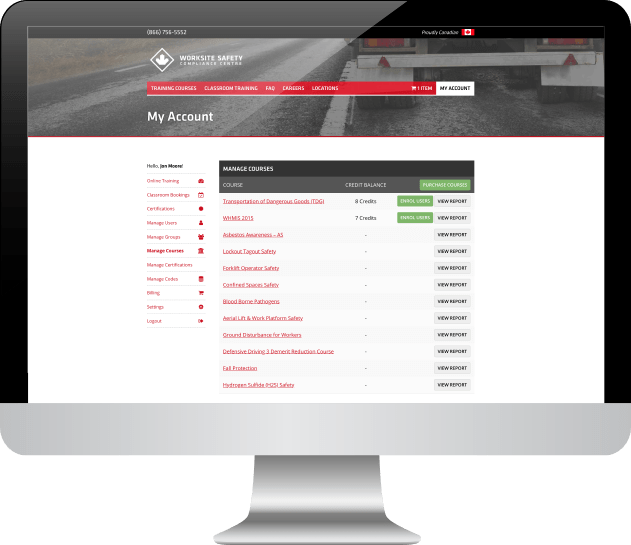
Additional Services
We put our team of professionals to work to build solutions that improve results, save time, relieve your budget and keep your people safe. In addition to our training programs, we also provide Consulting Services, Train The Trainer Solutions, Course Authoring, and Integration services.
Consulting Services
It is our mandate to develop plans and programs that meet the unique needs and environments where staff carry out their work on a daily basis, creating customized programs that deal with risks specifically for each situation.
Our consulting services include OHS Auditing, Safety Policy Development, Procedure Writing, Training Needs Analysis, Safety Inspections, Job Safety & Hazard Analysis, Emergency Response Planning, and Fall Prevention & Detection.
Train the Trainer
Customize and control the learning experience of your staff or customers with our Train the Trainer offerings and enjoy the peace of mind that comes with our lifetime complimentary update service.
These packages educate new trainers on how to deliver in-person training to adult learners. Packages include Instructor Certification courses, expanded reference manuals, ready to customize classroom presentations, exam templates, certificates, and participant guides for students.
Program Authoring
Deliver original content courses to your staff to address the unique hazards associated with your workplace.
Our team of industry leading instructional designers and subject matter experts are able to develop defensible, effective, and efficient training programs that you can deliver as elearning content, self-learning course books, reference materials for classroom teaching, or as an app that integrates with existing frameworks. Training programs can be something that is built from scratch, or modified using pre-existing course materials from our library or your own.

Have a Question? Ask an Expert.

ASSOCIATE LOG-IN
- Forgot your password?
- Member Log-in
- National Safety Code Standards
Obtaining an NSC Certificate Number
Additional research and resources.
- Technical Standard for Electronic Logging Devices
- Motor Carrier Operating Authority
- Automated and Connected Vehicles (AV/CVs)
- Ignition Interlock
- New Vehicle Information Statement (NVIS)
- Canadian Vehicle Status Management Program
- Canada's Road Safety Strategy
- Drugs and Driving
- Alcohol and Drug Crash Problem in Canada
- Distracted Driving
- Collision Data
- Upcoming Events
- Registration
- Preliminary Program
- Hotel and Travel
- General Information
- Planning Your Visit
- Guest Information
- Sponsorship
- 2024 Event Sponsors
- Past Annual Meetings
- Program Committee Fall Meetings
- North American Cargo Securement Harmonization Public Forum
- Board of Directors
- Program Committees
- 2021-2025 Strategic Plan
- Jennie Howie Government Member Award
- Road Safety Award
- Sean McAlister Service Recognition
- Distinguished Service Recognition
- Associates Program
- Requests for Proposals
- Career Opportunities
Providing guidance for legislative, regulatory, and administrative action with a focus on the driver, the vehicle, and the carrier
- National Safety Code
The National Safety Code (NSC) is a set of 16 standards developed by the member jurisdictions of CCMTA in consultation with the motor carrier industry to ensure road safety and facilitate the safe and efficient movement of people and goods across Canada.
With the deregulation of transportation in the late 1980’s there was a need for cross Canada harmonization and reciprocity in the management of commercial vehicles. In 1987, the federal, provincial, and territorial Ministers Responsible for Transportation and Highway Safety signed a memorandum of understanding to develop and implement a National Safety Code to encourage road safety, promote efficiency in the motor carrier industry, and achieve consistent safety standards across Canada.
The NSC is designed to create a comprehensive code of minimum performance standards for the safe operation of passenger and commercial vehicles. The NSC provides guidance for legislative, regulatory, and administrative action by each jurisdiction and focuses on three components: the driver, the vehicle, and the carrier. It has a specific focus on those responsible for the operation of commercial vehicles on the road, including trucks, buses, tractors, and trailers.
All provinces and territories use the NSC as the cornerstone of their commercial vehicle regulatory framework, with standards either adopted by reference into jurisdictional regulation or mirrored in provincial and territorial laws.
Download a copy of the National Safety Code (NSC) Fact Sheet
An NSC number is issued by the provincial/territorial government department in which the vehicle is registered (plated). CCMTA does not produce, supply, or keep a record of NSC Numbers.
- British Columbia
- New Brunswick
- Newfoundland and Labrador
- Northwest Territories
- Nova Scotia
- Prince Edward Island
- Saskatchewan
Cargo Securement
- Guidance and Interpretations - General (May 2016)
- Securement of Dressed Lumber and Similar Building Materials on Flatbed Trucks and Trailers (February 2011)
- Performance Limits of Heavy Trucks
- Assessing a Securement Method for the Transportation of Heavy Machinery Using a Combination of Highway Vehicles
- North American Load Security Research Project Summary Report
- Analysis of Heavy Truck Cargo Anchor Points
- Tests on Methods of Securement for ISO Containers
- Tests on Methods of Securement for Metal Coils
- Effect of Tiedowns on Wood Blocks Used as Dunnage
- Bending Strength of Trailer Stakes
- Tests on Methods of Securement for Large Boulders
- Tests on Methods of Securement for Thick Metal Plate
- Evaluation of the Strength and Failure Modes of Heavy Truck Cargo Anchor Points
- Effect of Cargo Movement on Tension in Tiedowns
- Load Capacity of Nailed Wood Blocking
- Friction Coefficients between Typical Cargo and Truck Decks
- Effect of Binder Type and Chain Length on Tension in Chain Tiedowns
- Effect of Cargo and Tiedown Characteristics on Equalization of Tension in the Spans of Tiedowns
- Dressed Lumber Tiedown Tests
- Experimental Evaluation of Friction Coefficients of Typical Loads and Trailer Decks under Vertical Vibration
- Slippage Tests with Anti-Skid Mats
Hours of Service
- Application guide - Commercial Vehicle Drivers Hours of Service Regulations (January 2007)
AVAILABLE FOR FREE DOWNLOAD OR ORDER
Complete National Safety Code (NSC) Standards
Available for free download.
Includes all 16 standards below, segmented by the individual standard for easy reference.
Individual NSC Standards
Available for free download and print version on a cost recovery basis.
Select an NSC Standard from the dropdown menu below to learn more.
NSC Standard 1
Single driver license concept.
A standard implemented by all jurisdictions which makes it an offence for a driver to hold more than one licence. In addition, a series of administrative procedures have been agreed upon to ensure driving infractions are assigned to a single licence and record.
NSC Standard 2
Knowledge and performance tests (drivers) revised january 2020.
The purpose of this standard is to ensure that applicants possess the fundamental knowledge and driving skills for the type of vehicle to be safely operated on Canadian roads.
CODE: NSC-E-STND2 $9.99 (PLUS SHIPPING) PRINT VERSION
NSC Standard 3
Driver examiner training program revised january 2020.
The purpose of this standard is to ensure that applicants possess the fundamental knowledge and skills for driver examiner training and testing for passenger vehicles, commercial or higher-class vehicles, motorcycles, and medically at-risk drivers.
Driver examiner standards assist in ensuring that examiners have met the minimum knowledge and skills training requirements for conducting licensing tests, with a focus on road and practical testing. This standard has been developed based on a number of objectives:
- To establish uniform performance standards for driver examiners.
- To facilitate consistent driver examination across Canada.
- To establish a system to ensure that driver examiners have and maintain the capability to perform their jobs competently.
CODE: NSC-E-STND3 $9.99 (PLUS SHIPPING) PRINT VERSION
NSC Standard 4
Driver licensing classification revised january 2020.
The purpose of this standard is to designate classes of vehicles for driver licensing and prescribe the fundamental knowledge and skills for the type of vehicle to be safely operated on Canadian roads.
CODE: NSC-E-STND4 $9.99 (PLUS SHIPPING) PRINT VERSION
NSC Standard 5
Self-certification standards and procedures.
A standard which outlines the criteria which must be met to permit carriers and driver training schools to train commercial drivers.
CODE: NSC-E-STND5 $9.99 (PLUS SHIPPING) PRINT VERSION
NSC Standard 6
Determining driver fitness in canada revised february 2021.
Driving a motor vehicle in Canada is a privilege that may be accorded to an individual by the driver licensing authority of the province or territory in which they live. In order to exercise a privilege such as driving, the individual must meet the specified criteria including the demonstration of an acceptable level of competence. To qualify for a driver’s licence an individual must, among other requirements, be able to demonstrate medical fitness to drive.
CCMTA has developed a standard entitled National Safety Code (NSC) Standard 6 – Determining Driver Fitness in Canada that sets the medical criteria used to establish whether drivers are medically fit to drive. It addresses both private and commercial drivers.
Part 1 of this document explains how Canadian jurisdictions perform their role in assessing the medical fitness of drivers while Part 2 contains the CCMTA Medical Standards for Drivers.
The NSC Standard contains the provincial/territorial contact information for reporting potentially unfit drivers . Driver assessment centres and rehabilitation resources can also be located in your area by contacting these offices.
CODE: MED-STD $15.99 (PLUS SHIPPING) PRINT VERSION
NSC Standard 7
Carrier and driver profiles revised november 2002.
A standard which is designed to provide jurisdictions with a record of driver and carrier performance in terms of compliance with safety rules and regulations. The standard supports enforcement activity to remove unsatisfactory drivers and carriers from service and identifies the type of information which will be maintained on each commercial driver and carrier.
CODE: NSC-E-STND7 $9.99 (PLUS SHIPPING) PRINT VERSION
NSC Standard 8
Short-term suspension.
A standard which describes the criteria for placing a driver out of service on a short-term (24 hour) basis when a peace officer has reasonable and probable grounds to believe the driver's ability is affected by alcohol or drugs.
NSC Standard 9
Commercial vehicle drivers hours of service revised february 2022.
A standard which describes the number of hours a commercial driver can be on duty and operate a commercial vehicle. It outlines the requirement to complete daily logs, describes the various cycles of operation and sets out driver and carrier record keeping requirements.
CODE: NSC-E-STND9 $9.99 (PLUS SHIPPING) PRINT VERSION
NSC Standard 10
Cargo securement revised june 2013.
A standard which outlines the specific requirements for securing loads to commercial vehicles to ensure they do not shift, move, or spill onto the roadway.
Previous Editions (superseded) September 2010 version September 2004 version
Revision History Amended June 2013 Summary of changes 2013 Amended September 2010 Summary of changes 2010 Introduced September 2004
CODE: NSC-E-STND10 $9.99 (PLUS SHIPPING) PRINT VERSION
NSC Standard 11
Commercial vehicle maintenance and periodic inspection revised january 2020.
A standard which outlines maintenance and periodic inspections.
CODE: NSC-E-STND11 $75.00 (PLUS SHIPPING) PRINT VERSION
NSC Standard 12
Cvsa on-road inspections.
A standard which contains the Commercial Vehicle Safety Alliance on-road inspection criteria. Please contact the Commercial Vehicle Safety Alliance for a copy.
NSC Standard 13
Trip inspection revised march 2009.
A standard which prescribes daily trip inspection requirements. The daily vehicle trip inspection standard is intended to ensure early identification of vehicle problems and defects, and to prevent the operation of vehicles with conditions that are likely to cause or contribute to a collision or vehicle breakdown. Daily vehicle trip inspection is a continuous process designed to protect drivers and alert carriers to mechanical problems. The general objective of daily vehicle trip inspections is to promote an improved level of safety and compliance in commercial vehicles operating on the highway.
CODE: NSC-E-STND13 $9.99 (PLUS SHIPPING) PRINT VERSION
NSC Standard 14
Safety rating revised august 2009.
A standard which establishes the motor carrier safety rating framework by which each jurisdiction assesses the safety performance of motor carriers.
CODE: NSC-E-STND14 $9.99 (PLUS SHIPPING) PRINT VERSION
NSC Standard 15
Facility audits update december 2003.
A standard which outlines the audit process used by jurisdictions to determine a carrier's level of compliance with all applicable safety standards.
CODE: NSC-E-STND15 $9.99 (PLUS SHIPPING) PRINT VERSION
NSC Standard 16
Commercial truck driver entry level training (class 1) new january 2021.
A standard designed to ensure that Class 1 commercial truck drivers are properly and consistently trained before they are licensed.
CODE: NSC-E-STND16 $9.99 (PLUS SHIPPING) PRINT VERSION
Canadian Council of Motor Transport Administrators
1111 prince of wales suite 404 ottawa, ontario canada k2c 3t2, t: 613.736.1003 f: 613.736.1395 email: [email protected], discover more.
- Commercial Motor Vehicle Safety
CCMTA acknowledges it is located on the traditional, unceded territory of the Algonquin Anishinaabe people.
Ontario.ca needs JavaScript to function properly and provide you with a fast, stable experience.
To have a better experience, you need to:
- Go to your browser's settings
- Enable JavaScript
Daily inspection test
On this page skip this page navigation, introduction and overview.
The purpose of the daily inspection test is to determine if you have the knowledge and skills required to determine the safe operation of the vehicle and identify any of the prescribed minor or major defects as listed in the applicable schedule(s) in the ntario Regulation: O. Reg. 199/07.
The daily inspection test is divided into the following sections and will be performed in the following order:
Exterior inspection
In-cab check, interior inspection.
The exterior and interior portions of the daily inspection test will be administered using a randomized selection of testing items from the applicable Schedule 1 in Regulation O. Reg. 199/07 . This will ensure that you are prepared to inspect all components of the vehicle.
You will be required to inspect all items listed for the in-cab portion of the test. You will be permitted to use the applicable Schedule as a guide and reference during the daily inspection test.
The exterior inspection of the vehicle must be performed with the parking brake engaged and the wheels chocked.
You will be asked to find and inspect four randomly generated items from the list below and be required to:
- Demonstrate and describe how you would inspect the particular item.
- Explain what the defect(s) would be for the particular item.
- Describe what action you would take upon identifying a minor and/or major defect.
For any road test where the vehicle is equipped with air brakes, you will be expected to be prepared to inspect any of the air brake components of the vehicle listed in this section. The list will also provide inspection methods for each item.
Exterior Items
1. slow air pressure build-up rate.
You must know the proper method for testing the air pressure build-up rate, and that a vehicle has this minor defect when it takes longer than two minutes for air pressure to build up from 85 to 100 psi .
- Ensure the trailer supply valve is closed (pulled out when equipped).
- Release the parking brake.
- Pump brakes to reduce air pressure to 552 kPa (80 psi or less).
- Maintain engine speed of 600 to 900 RPM .
- Note time for pressure to rise from 587 to 690 kPa (85 to 100 psi ) while maintaining specified engine speed.
- Note the build-up time and tell the examiner.
2. Audible air leaks
You must know that it’s necessary to check for leaks regularly, and a vehicle has this minor defect when any air leak can be heard.
Air loss rate exceeds the prescribed limit
You must know the proper method for testing the air-loss rate, and that a vehicle has this major defect when the air pressure drops in one minute more than the prescribed limit of:
- 21 kPa (3 psi in one minute
- Tell the examiner, “For any air leaks heard at any time, I would conduct the air-loss rate test.”
- Ensure the vehicle is secured by wheel chocks.
- Release all spring parking/emergency brakes.
- Ensure the air-system pressure is between cut-in and cut-out values (80 -135 psi ); shut off the engine and turn the key on (if required).
- Hold the brake pedal in the fully applied position.
- Observe the air pressure gauges for one minute and note any change. (Disregard the initial pressure drop and begin test after the pressure has stabilized.)
3. Pushrod stroke of any brake exceeds the adjustment limit
You must know the proper method for checking brake pushrod stroke, and that a vehicle has this major defect when the pushrod stroke of any brake is longer than the prescribed limit.
Certain vehicles do not provide access to measure the applied pushrod stroke (buses, low slung vehicles and vehicles with obstructive fairing or body panels, or vehicles equipped with air disk brakes). In such cases the examination is conducted verbally.
Here are the steps you must take to measure applied pushrod stroke.
- Secure the vehicle with wheel chocks or blocks.
- Ensure air pressure is above 621 kPa (90 psi ) and release the spring brakes.
- Method 1: Mark the pushrod at the brake chamber or at a suitable fixed reference point. (Use chalk, soapstone, marker or other similar instrument. Marks must be narrow and precise.)
- Method 2: Measure the released position of the pushrod. (Measure and note the distance from a point on the pushrod to a suitable fixed point at the brake chamber. This is measurement number 1.)
- Raise or lower the air pressure by running the engine or pumping the brake pedal until both the primary and secondary air-tank gauges display 621 to 690 kPa (90 to 100 psi ).
- Shut off the engine.
- Press and hold the brake pedal in the fully applied position
- Method 1: Measure the distance from the brake chamber or fixed reference point to the mark on the pushrod.
- Method 2: Measure the applied position of the pushrod. (Re-measure and note the distance from the previously selected point on the pushrod to the previously selected fixed point at the brake chamber. This is measurement number 2.) Subtract measurement 1 from measurement 2 to calculate the applied pushrod stroke measurement.
- Determine the number size (such as 16, 20, 24 or 30) and type (such as standard or long-stroke) of the brake chamber.
- Determine and indicate to the examiner the adjustment limit for the brake chamber.
- Compare the applied pushrod stroke to the applicable adjustment limit to determine if any brake exceeds the adjustment limit.
4. Low-air warning system fails or system is activated
You must know the proper method for testing the low-air warning, and that a vehicle has this major defect when the low air-warning fails to activate or activates before air pressure drops below 55 psi .
- Ensure air pressure is above 621 kPa (90 psi ). If air pressure is too low, warning may activate as soon as ignition key is turned on.
- Ensure ignition key is turned on. Engine may be running or shut off (If ignition key is not turned on, the warning will not activate)
- Press and release the brake pedal (to lower pressure) several times until warning activates.
- Watch the pressure gauges and note the pressure when the low-air warning device activates (Low-air warning device may be only a light, or a light and an audible device.)
5. Exhaust System‒ALL
Exhaust leak.
You must know how to visually inspect the exhaust system, and that a vehicle has this minor defect when there’s a noticeable exhaust leak.
Exhaust leak that causes exhaust gas to enter the occupant compartment
You must know the hazard of prolonged exposure to engine exhaust gases, and that vehicle has this major defect when exhaust gases from an exhaust-system leak are getting into the cab.
- With the vehicle running, open the hood or other compartments as required and inspect the complete exhaust system to ensure there are no signs of exhaust leaks.
6. Glass and Mirrors‒C/F
Required mirror or glass has broken or damaged attachments onto vehicle body.
You must know that the windows and mirrors that are necessary for safe operation must also be securely attached to vehicle, and that the vehicle has this minor defect when the attachments for any required mirror or other glass are broken or damaged.
- Inspect the vehicle to ensure all external mirrors and mirror attachments onto the vehicle body are secure, not broken or damaged.
7. Hydraulic Brake System‒ALL
Brake fluid level is below indicated minimum level and brake fluid reservoir is less than one-quarter full.
You must know the location of the hydraulic brake master-cylinder reservoir, how to check the level of the brake fluid, and that the vehicle has this minor defect when brake fluid level is below the mark indicating the minimum level as determined by the manufacturer, or a major defect when the reservoir is less than one-quarter full.
Brake fluid leak
You must know that brake fluid is required for the system to operate, that loss of brake fluid can cause the brakes to malfunction or fail completely, and that a vehicle has this major defect when there is a brake fluid leak.
Open the hood and inspect brake-fluid reservoirs to ensure:
- Brake fluid is above the minimum required level.
- There is no brake fluid leak.
- Brake-fluid reservoir is not less than one-quarter full.
8. Suspension System‒ALL
Air leak in air-suspension system.
You must know that a vehicle has a minor defect when an air leak is noticeable in the air-suspension system.
Damaged (patched, cut, bruised, cracked to in braid or deflated) air bag
You must know the normal appearance of air bags used in vehicle suspension systems, and be able to recognize the signs of damage and identify when the damage may also cause an air bag to be deflated. You must also know a vehicle has a major defect when any air bag is damaged and has no air in it.
- Inspect the vehicle (or describes the process) to ensure an air leak is not noticeable in the air- suspension system and any air bag is not damaged and has air in it.
9. Suspension System‒ALL
Broken leaf spring.
You must know the importance of doing a visual inspection of leaf springs, and how to identify broken leaf spring, and that a vehicle has this minor defect when any spring has a single broken leaf.
Cracked or broken main spring leaf or more than one broken leaf spring
You must know which leaves in a spring are considered to be “main” leaves, and that a vehicle has this major defect when either a main leaf or more than one other leaf is broken.
Part of leaf spring or suspension is missing, shifted out of place, in contact with another vehicle component
You must know the condition of the suspension-system components, and the hardware that attaches it to the vehicle need to be inspected visually; you must be able to recognize the signs of more serious unsafe suspension-system conditions, and that a vehicle has this major defect when any part of a leaf spring or suspension part is missing, has shifted out of place or is in contact with another vehicle component.
Broken spring on other than a leaf spring system (Class B/E only)
You must know the importance of doing a visual inspection of springs and how to identify a broken spring, and that vehicle has this major defect when any spring other than a leaf spring is broken.
- Inspect the vehicle (or describe the process where not accessible) to identify any cracked or broken springs, spring leaves, or a spring leaf or suspension part is missing, has shifted out of place or is in contact with another vehicle component.
10. Suspension System‒ALL
Suspension fastener is loose, missing or broken.
You must know the condition of the suspension-system components and the hardware that attaches it to the vehicle need to be inspected visually; you must be able to recognize the signs of loose, missing or broken components, and also know that a vehicle has this minor defect when any suspension fastener is loose, missing or broken.
Loose U-bolt
You must know how to locate and identify suspension U-bolts, know the importance of ensuring they remain tight and the signs of loose U-bolts. You must also know that a vehicle has this major defect when any spring U-bolt is loose.
- Inspect the condition of the suspension-system components and the hardware, including suspension fasteners and U-bolts, that attaches it to the vehicle for any visual signs of loose, missing or broken components.
11. Tires: Leaks‒ALL
Tire leaking, if leak cannot be heard.
You must know the importance of keeping tires properly inflated, appreciate the need to regularly check for leaks, and that a vehicle has this minor defect when a leak appears evident, but cannot be felt or heard in any tire.
Flat tire and tire leaking, if leak can be felt or heard
You must know the dangers of operating with a flat tire, and that a vehicle has this major defect when any tire is flat, or when a leak can be felt or heard.
- Select one tire of the vehicle and inspect it by listening and feeling for any leaks. Note: Kicking the tires or using a mallet to check for flats is acceptable.
12. Tires: Damage and Tread‒ALL
Damaged tread or sidewall of tire You must be able to distinguish between the tread and sidewall of a tire, and know the visual signs of tread and sidewall damage, and know that a vehicle has this minor defect when there is damage to the tread or sidewall area.
Tire tread depth is less than wear limit You must know how to check tire-tread depth and the minimum allowable depth for various tire positions in vehicle safety regulations, and that a vehicle has this major defect when any tire’s tread depth is below the allowable wear limit.
Tire is in contact with another tire or any vehicle component other than mud flap You must know that tires should never contact other vehicle components, and while a tire contacting a mud flap is not a safety concern, a vehicle has this major defect when any tire is in contact with another tire or any other vehicle component.
Tire has exposed cords in the tread or outer sidewall area You must know that tires are constructed with steel cords inside their casings, which are covered in rubber for protection, and that a vehicle has this major defect when cords are exposed in the tread or sidewall of any tire.
Procedure: Select one tire of the vehicle and inspect it:
- For any visual signs such as cuts or other damage to treads and sidewalls
- To ensure the depth is greater than the minimum allowable depth for the tire positions in vehicle safety regulations (3mm steer tire and 1.5 mm for other tires)
- To ensure there is no contact with any other tire or vehicle components other than a mud flap
- For any exposed cords in the tread or sidewall of any tire
13. Wheels, Hubs and Fasteners‒ALL
Hub oil below minimum level (when fitted with sight glass) You must know that wheel hubs use bearings that require lubrication, that oil is often used as a bearing lubricant, that hub caps used with oil-lubricated bearings may have a clear window allowing a visual inspection of the oil fill level, and that a vehicle has this minor defect when you can see that the hub-oil level is below minimum.
Leaking wheel seal You must know that wheel hubs require seals to keep the lubricant inside the hub; when a wheel seal is leaking, the wheel bearing can fail, and that a vehicle has this minor defect when there is evidence of a leaking wheel seal.
Evidence of imminent wheel, hub or bearing failure You must know the normal appearance of wheel and hub components, the visual indications of more serious unsafe conditions, and that a vehicle has this major defect when there is visual evidence that a wheel, hub or bearing failure could occur.
Procedure: The examiner will select one wheel and require you to:
- Where sight glass is present (or describe the procedure if not present), inspect the hub-oil level to ensure oil is above the minimum level.
- Inspect to ensure there is no evidence of a leaking wheel seal – look inside the wheel for oil and stains.
- Inspect to ensure there is no visual evidence that a wheel, hub or bearing failure could occur.
14. Wheels, Hubs and Fasteners‒ALL
Wheel has loose, missing or ineffective fastener You must know the visual features of different types of wheel systems; the importance of keeping wheel fasteners (normally nuts and bolts) properly tightened; be able to detect missing fasteners and recognize the visual signs of loose or ineffective fasteners; and know that a vehicle has this major defect when any wheel has a loose, missing or ineffective fastener.
Evidence of imminent wheel, hub or bearing failure You must know the normal appearance of wheel and hub components and the visual indications of more serious unsafe conditions, and that a vehicle has this major defect when there is visual evidence that a wheel, hub or bearing failure could occur.
- Inspect for any missing fasteners and recognize the visual signs of loose or ineffective fasteners such as a gap between nut and wheel.
15. Wheels, Hubs and Fasteners‒ALL
Damaged, cracked or broken wheel, rim, attaching part You must know the visual features of different types of wheel systems, the normal appearance of the individual components, and that a vehicle has this major defect when any wheel, rim, or any part used to attach the wheel or rim, is damaged, cracked or broken.
The examiner will select two wheel assemblies and require you to:
Inspect inner and outer wheel assembly (open hood if access will improve visibility) to ensure:
- Any wheel, rim, or any part used to attach the wheel or rim, is not damaged, cracked or broken.
- There is no visual evidence that a wheel, hub or bearing failure could occur.
16. Alternating Overhead Lamps–B/E
A lamp is missing or inoperative You know which lamps on the bus are required, and that the bus has this minor defect when any lamp is missing or inoperative. And that it is a major defect when the use of lamp is required, and any lamp is missing or inoperative.
Lamps do not alternate You know which lamps on the bus alternate and that the bus has this minor defect when any lamp does not alternate. And that it is a major defect when the use of lamp is required and any lamp does not alternate.
A lamp is not of the proper colour You know that the proper colour lamps on the bus are required, and that the bus has this minor defect when any lamp is not of the proper colour and a major defect when the use of lamp is required and a lamp is not of the proper colour.
- Activate alternating overhead lamps and ensure they function properly.
17. Doors and Windows, other than Emergency Exits–B/E
A window or door fails to open or close securely You must know that any window or door must be able to open and close securely, and that a vehicle has this minor defect when any window or door fails to open or close securely.
When carrying passengers, door fails to open or close securely You must know that, when carrying passengers, a door must open and close as intended, and that a vehicle has this major defect when any door fails to work properly.
- Test the function of the window or door by opening and closing to ensure it opens and closes properly.
18. Emergency exits‒ALL
Required alarm is inoperative You must know how the required alarm functions, and that a vehicle has this minor defect when the required alarm is inoperative and a major defect when carrying passengers and the required alarm is inoperative.
When carrying passengers:
- Window fails to open from inside or close securely You must know that, when carrying passengers, windows must be able to open and close securely, and that a vehicle has this major defect when windows fail to open or close securely.
- Door fails to open freely from inside and outside You must know that, when carrying passengers, a door must open and close as intended, and that a vehicle has this major defect when any door fails to work properly.
- Test the function of the window or door to ensure it opens and closes properly and the required alarm is operative.
19. Exterior Body and Frame‒ALL
Insecure or missing body parts You must know that secure vehicle body parts are necessary for safe operation, and the vehicle has this minor defect when any body parts are insecure or missing.
Insecure or missing compartment door You must know that the compartment door is necessary for safe operation, and must be securely attached to the vehicle. And that the vehicle has this minor defect when the compartment door is insecure or missing.
Damaged frame or body You must know that some conditions of the frame or cargo body can be serious safety concerns, and that a vehicle has this minor defect when it is visible that a frame or body is damaged.
One or more visibly shifted, cracked, collapsing or sagging frame member You must know that some conditions of the frame or cargo body can be very serious safety concerns, and that a vehicle has this major defect when it is visible that any frame component has shifted, is cracked, collapsing or is sagging.
Procedure: Inspect one side of the vehicle and open the hood (front-engine bus) to check for any:
- Insecure or missing body parts
- Insecure or missing compartment door
- Damaged frame or body
- One or more visibly shifted, cracked, collapsing or sagging frame member
20. Mirrors–B/E
Mirror has broken or damaged attachments onto vehicle body You must know that the mirrors are necessary for safe operation, and must also be securely attached to vehicle body. And that the vehicle has this defect when the attachments for any required mirror are broken or damaged.
A mirror is missing or broken You must know that the mirrors are necessary for safe operation, and must also be securely attached to vehicle. And that the vehicle has this major defect when the required mirror is missing or broken.
The glass surface of a mirror has an aggregate non-reflective area exceeding 6.5 square centimeters You must know the importance of the glass surface of a mirror, and that a vehicle has this major defect when the glass surface of a mirror has an aggregate non-reflective area exceeding 6.5 square centimetres.
Procedure: Inspect vehicle to ensure:
- Any mirror attachment onto the vehicle body is not broken or damaged.
- A mirror is not missing or broken.
- The glass surface of any mirror does not have a non-reflective area of more than 6.5 square centimetres.
21. Pedestrian/Student Safety Crossing Arm–B/E
The arm is missing or fails to function as intended You must know the student safety arm is securely mounted and functions properly, and that a vehicle has this minor defect when the arm is missing or fails to function as intended.
- Inspect vehicle to ensure that the student safety crossing arm is securely mounted and functions properly in conjunction with stop arm (gate).
22. Stop Arm (if not equipped, must verbalize)–B/E
If equipped with flashing lamps to illuminate letters of the word “STOP,” any lamp is partially or wholly inoperative:
- Stop arm or stop sign is missing You must know when the stop arm or stop sign is required, and a vehicle has a minor defect when missing and a major defect when the stop arm or stop sign is required and missing.
- Stop arm or stop sign is damaged so as to significantly affect visibility You must know when the stop arm or stop sign is required and a vehicle has a minor defect when damaged so significantly to affect visibility and a major defect when the stop arm or stop sign is required and damaged significantly affecting visibility.
- Stop arm will not extend fully or stay fully extended You must know how the stop arm functions, and the vehicle has a minor defect when it will not extend fully or stay fully extended, and a major defect when the stop arm or stop sign is required and will not extend fully or stay fully extended.
- Either light on stop arm is inoperative, lights do not alternate or lights are not red You must know when the light on the stop arm is required, and the vehicle has a minor defect when either light on the stop arm is inoperative, lights do not alternate or are not red, and a major defect when either light on the stop arm is required and is inoperative, lights do not alternate or are not red.
Procedure: Inspect the vehicle to ensure the stop arm:
- Lights function.
- Is mounted securely to the vehicle frame and is not damaged.
- Extends fully when operated.
Once the exterior inspection is complete, you will enter the vehicle and begin the in-cab check portion of the test, where you must point to or touch all items and fully explain what you are inspecting for each item. You are not required to list the minor or major defects.
During the in-cab check portion of the test you will be expected to start the vehicle and perform the following checks:
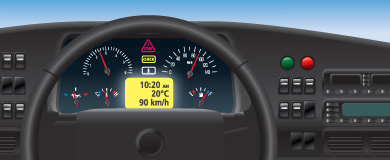
Once the in-cab check is complete, you will find and inspect two randomly generated items from the applicable Schedule and be required to:
1. Driver Seat‒C/F
Seat is damaged or fails to remain in set position You must know that the driver seat must be properly positioned to be able to control the vehicle, know the methods for confirming the seating positions, as well as the locking methods, and that the vehicle has this minor defect when the seat is damaged or won’t stay in the position needed to drive. Seat belt or tether belt is insecure, missing or malfunctions You must know the importance of seat belts, how to properly wear them and the condition they must be in to function properly. You must know that a vehicle has this major defect when any seat belt or tether belt is insecure, missing or malfunctions. Procedure: Inspect:
- Driver seat to ensure it is not damaged and will stay in the position needed to drive.
- Seat belt to ensure tether belt is secure and works correctly clipped and unclipped.
2. Emergency Equipment and Safety Devices‒C/F
Emergency equipment is missing, damaged or defective You must know what emergency equipment is required for the type of transport you are involved in, how to check it, and that a vehicle has this minor defect when any necessary emergency equipment is missing, damaged or doesn’t work properly. Procedure:
- Verbally identify where the emergency flares, lamp or reflectors are located and that they are working properly and secure.
3. Heater / Defroster‒ALL
Control or system failure You must know the importance of the heater/defroster always being available for keeping the windshield clear of condensation, and that a vehicle has this minor defect when the heater/defroster system operates incorrectly. Procedure:
- Turn on heater/defroster fan for all directional controls/ positions and ensure the system operates correctly in all positions.
- When applicable, ensure the defroster keeps the windshield clear.
4. Glass and Mirrors‒C/F
Required mirror or window glass fails to provide the required view to the driver as a result of being cracked, broken, damaged, missing or maladjusted You must know the importance of always having a clear view of the conditions around the vehicle, the windows and mirrors that are required on the vehicle, and that a vehicle has this minor defect when there’s mirror- or window-glass damage that reduces this needed visibility.
- Inspect mirrors and windows for any cracks or damage that reduce the required view to the driver, and ensure mirrors are properly adjusted.
5. Windshield Wiper / Washer
- Wiper blade damaged, missing or fails to adequately clear driver’s field of vision You must know the normal condition and function of wiper blades, and be able to recognize when they no longer function well, and that a vehicle has this minor defect when a wiper blade is damaged, missing or won’t clear the area of the windshield in front of the driver.
- Control or system malfunction You must know how to operate the windshield wipers and washers, know that ensuring they are available at all times requires periodic testing, and that a vehicle has this minor defect when the control or any part of the system fails to function properly.
- When use of wipers or washer is required: wiper or washer fails to adequately clear driver’s field of vision in area swept by driver’s side wiper You must know that being able to see the roadway clearly in poor weather is very important, that this visibility is dependent on the wipers being able to clear water, snow and ice from the windshield, and that a vehicle has this major defect when the prevailing weather conditions require use of the wipers or washers, and they are not able to keep clear the area swept by the driver’s side wiper.
- Control or system malfunction – minor or major when use of wipers or washer is required
- Wiper blade damaged, missing or fails to adequately clear driver’s field of vision – minor or major when use of wipers or washer is required
- Wiper or washer fails to adequately clear the windshield in the areas swept by both wipers – minor or major when use of wipers or washer is required
- The windshield wipers and washers function properly in all directions.
- Any wiper blade is not damaged or missing, and will clear the windshield.
6. Passenger Compartment
Class b/e and c/f:.
- Stanchion padding is damaged You know how to inspect the stanchion padding, and that the vehicle has this minor defect when the stanchion padding is damaged.
- Damaged steps or floor You know how to inspect the steps and floor, and that the vehicle has this minor defect when they are damaged.
- Insecure or damaged overhead luggage rack or compartment You know how to inspect the overhead luggage rack or compartment, and that the vehicle has this minor defect when the overhead luggage rack or compartment is insecure or damaged.
- Malfunction or absence of required passenger- or mobility-device restraints You know how to inspect the required passenger- or mobility-device restraints, and that the vehicle has this minor defect when they malfunction or are missing; and that it is a major defect when the affected position is occupied and the required passenger- or mobility-device restraints malfunction or are missing.
- Passenger seat is insecure You know how to inspect the passenger seat, and that the vehicle has this minor defect when it is insecure; and that it is a major defect when the passenger seat is occupied and the seat is insecure.
Procedure: Inspect passenger compartment and seat to ensure:
- Stanchion padding is not damaged.
- Steps or floor are not damaged.
- Overhead luggage rack or compartments are secure and not damaged.
- Required passenger- or mobility-device restraints function properly.
- Passenger seat is secure.
7. Emergency Equipment and Safety Devices‒B/E
Emergency flares, lamps or reflectors:
- Missing or insecure You know what emergency equipment is required for the vehicle, how to check it, and that a vehicle has this minor defect when any emergency flares, lamps or reflectors are missing, damaged or don’t work properly.
Fire extinguisher:
- Fire extinguisher is missing You know that a fire extinguisher is required, how to inspect it, and that the vehicle has this minor defect when the fire extinguisher is missing, and that it is a major defect when missing and carrying passengers.
- The gauge on any required fire extinguisher indicates an empty condition or a complete lack of pressure You know how to inspect a fire-extinguisher gauge, and that the vehicle has this minor defect when the gauge indicates an empty condition or a complete lack of pressure; and that it is a major defect when the gauge on any required fire extinguisher indicates an empty condition or a complete lack of pressure when carrying passengers.
- Fire extinguisher is not securely mounted or stored in a manner that prevents the extinguisher from being a projectile object You know when a fire extinguisher is securely mounted, and that the vehicle has a minor defect when the fire extinguisher is not securely mounted or stored in a manner that prevents the extinguisher from being a projectile object.
First aid kit:
- Required first aid kit is missing You know where the required first aid kit is located, and that the vehicle has this minor defect when the required first aid kit is missing, and that it is a major defect when carrying passengers and the required first aid kit is missing.
- Kit is incomplete You know where the required first aid kit is located, and that the vehicle has this minor defect when the kit is incomplete.
Procedure: Identify where the emergency equipment and safety devices listed below are located, and describe that they are working properly and secure:
- Emergency flares, lamp or reflectors
- Fire extinguisher
- First aid kit
8. Seat and Seat Belt–B/E
- Driver’s seat fails to remain in set position You must know that the driver seat must be properly positioned to be able to control the vehicle, and know the methods for confirming the seating positions, as well as the locking methods; and that the vehicle has this minor defect when the seat won’t stay in the set position needed to drive.
- Restraint system for passenger in mobility device or mobility-device restrain system, or component of either system, is missing or defective You know how to inspect the restraint system for a passenger in a mobility device or mobility-device restrain system, and that the vehicle has this minor defect when the device is missing or defective.
- Required restraint system or component of required restraint system is missing You know how to inspect the required restraint system or component of it, and that the vehicle has this minor defect when the device is missing; and that it is a major defect when the affected position is occupied, and the required restraint system or component is missing.
- Restraint system or component of restraint system is defective You know how to inspect the restraint system or component of it, and that the vehicle has this minor defect when the device is defective; and that it is a major defect when affected position is occupied, and the restraint system or component is defective.
- Seat is insecure You must know how to inspect the driver seat, and that the vehicle has this minor defect when the seat is insecure; and that it is a major defect when affected position is occupied, and the seat is insecure.
- Passenger restraint system, mobility-device restraint system, or component of either system, is missing or defective You know how to inspect the passenger restraint system, and that the vehicle has this major defect if the system is missing or defective when the affected position is occupied.
- Passenger seat or passenger-protection barrier is insecure You must know how to inspect the passenger-protection barrier, and that the vehicle has this major defect when affected position, or position behind, is occupied and passenger seat or passenger-protection barrier is insecure.
- Seat back or passenger-protection barrier padding is missing, partially missing or has shifted from position so as not to be effective You must know how to inspect the seat back or passenger-protection barrier padding, and that the vehicle has this major defect when affected position, or position behind, is occupied, and seat back and passenger or passenger-protection barrier padding is missing, partially missing or has shifted from position as not to be effective.
9. Doors and Emergency Exits‒C/F
Door, window or hatch fails to open or close securely You must know that any window, door or hatch must be able to be opened and closed securely, and that a vehicle has this defect when any window or door fails to open or close securely.

COMMENTS
Drivers play an important part in making sure that trucks and buses using Ontario highways are in good operating condition. The most effective method for drivers to determine that their vehicle is in safe operating condition is to do a daily vehicle inspection (also known as a circle check or a pre-trip inspection) before starting the day's trip.
ReadyChek, Inc - Paperless CVOR / NSC Pre Trip Vehicle Inspections and Hours of Service App. ReadyChek's vehicle inspection reporting app is a fast and easy way to help drivers record paperless pre and post trip daily inspections and hours of service with Ontario's MTO vehicle schedules and Canada's NSC Standard 13.
Pre-trip inspections are valid for 24 hours. Ontario regulations contain inspection "schedules" that drivers must use when inspecting the vehicles. The inspection schedules list vehicle parts and what defects would be considered minor defects or major defects of those vehicle parts.
Daily vehicle trip inspection is a continuous process designed to protect drivers and alert carriers to mechanical problems. The general objective of daily vehicle trip inspections is to promote an improved level of safety and compliance in commercial vehicles operating on the highway. .
sequenced pre-trip inspection including the airbrake system/ verification Field/Hands-On Activities Thorough and sequential Pre-Trip Inspection ... Details are set out in the Ontario Highway Traffic Act Regulation 575 (regulation 199/07, effective May 2007), and explain that
In this online Pre-Trip Inspection course, the following topics are covered: Module 1: Preparing for the Pre Trip Inspection. This module covers how a truck driver should perform a pre trip inspection and includes the necessary safety precautions that should be taken while all vehicle inspections are performed. This module also discusses the ...
Drivers of a commercial truck or tractor trailer with a gross weight exceeding 4,500 kg are responsible for completing a schedule 1 pre-trip inspection on their vehicle. A pre-trip inspection is required before the start of each driving shift and once over the course of every 24 hours while on the road. Before heading out on the road, drivers ...
Ontario or short trips across town, it is necessary to walk around your vehicle to inspect key vehicle components and confirm they are in proper operating ... Daily Pre-Trip Inspection & Mileage Log V2 - combination of daily pre-trip and business mileage tracker (DOCX 15KB, PDF 240KB). Daily Inspection and Maintenance Form
Program Description. The purpose of this legislation is to identify vehicle problems and defects before the vehicle is driven on the highway as per the Ontario Highway Traffic Act and regulations. Driver daily vehicle Inspections are a crucial step to preventing the operation of vehicles with conditions that are likely to cause or contribute to ...
DAILY PRE-TRIP STRAIGHT TRUCKS. This program is designed for straight trucks (without a trailer). Pre-trip inspections are an integral part of every road trip for a trucker. Proper pre-trip inspections are important for proper fleet maintenance and they are required by law. Finding problems at the yard before you leave on a run will save a ...
Inspection action r N/A Comments Driver's seat Adjust seat distance and angle to improve driving position Head restraints More than 2" inches from head. Top of restraint in line with top of head Safety belts* Examine for wear Instrument panel * Check for red or orange/ yellow symbols Brakes* Test for soft or hard pedal feel. Test action of
Learn how to create truck pre-trip inspection form for Canada in our blog. Ensure your fleet is compliant and safe with effective inspection processes. ... For example, in Ontario, under the Highway Traffic Act, a commercial vehicle driver can be fined $250 for failing to perform a pre-trip inspection or failing to carry out a required safety ...
Ontario is among the first (Saskatchewan actually begins hard enforcement of the regulations on July 1) to implement the new rules. Ontario's new daily trip inspection regulations can be viewed online at: www.e-laws.gov.on.ca under the Highway Traffic Act section. The new regs are called Commercial Motor Vehicle Inspections O/Reg 199/07.
MTO transport enforcement officer Chad King walks us through a pre-trip inspection. Defects have been planted on the vehicle, which the competitor must identify. This year in the Ontario Truck Driving Championships, for the first time ever, three drivers aced the pre-trip with perfect scores. They were: Mike Hamilton, City of Brampton; Wayne ...
Post Trip Inspection. PRE-TRIP INSPECTIONS COURSE ASSESSMENT: Testing conducted throughout this online course is designed to reinforce the information presented. Participants are able to repeat the course as many times as is needed if the pass mark is not achieved on the first attempt. (7 Reviews) 4.86 / 5.00.
sequenced pre-trip inspection including the airbrake system/ verification Field/Hands-On Activities Thorough and sequential Pre-Trip Inspection ... Details are set out in the Ontario Highway Traffic Act Regulation 575 (regulation 199/07, effective May 2007), and explain that
Daily vehicle trip inspection is a continuous process designed to protect drivers and alert carriers to mechanical problems. The general objective of daily vehicle trip inspections is to promote an improved level of safety and compliance in commercial vehicles operating on the highway. ... Ottawa, Ontario Canada K2C 3T2. Contact Us. T: 613.736. ...
MTO's Mark Bonner walks us through the pre-trip inspection portion of the competition.
Introduction and overview. The purpose of the daily inspection test is to determine if you have the knowledge and skills required to determine the safe operation of the vehicle and identify any of the prescribed minor or major defects as listed in the applicable schedule(s) in the ntario Regulation: O. Reg. 199/07. The daily inspection test is divided into the following sections and will be ...
After attending this course, participants will understand how to properly inspect each of the 23 items listed on Schedule 1. Member - $250 | Non-Member - $450. 4 hrs. Yes, issued by OTA. Thursday, October 24, 2024. Ontario Trucking Association 555 Dixon Road Toronto, ON M9W 1H8.